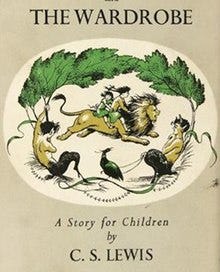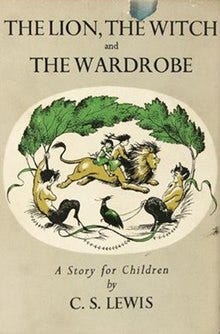How is the Professor’s house like a church?
“I should warn you that this is a very strange house, and even I know very little about it.” The Professor in The Lion, the Witch and the Wardobe
The narrator of The Lion, The Witch and the Wardrobe tells us very explicitly that “the adventures began” because the Pevensie children decided to explore the Professor’s house. So we need to give the house itself some thought. It is, the Professor tells the children, “very strange” and the narrator adds that it is also “old and famous”. So what is this place?
A clue comes shortly after the children start exploring because “soon they came to a very long room full of pictures and there they found a suit of armour; and after that was a room all hung with green, with a harp in one corner; and then came three steps down and five steps us, and then a kind of little upstairs hall and a door that led out on to a balcony, and then a whole series of rooms that led into each other and were lined with books”.
This passage sounds very much like one in Lewis’s planetary romance, That Hideous Strength, published just five years earlier. In that great book (probably my favourite among all his works), Jane Studdock travels to a strange house at St Anne’s on the Hill where she is taken to see the Director, a Mr Fisher-King: “They passed out into the plain, narrow passage and thence up shallow steps into a large entrance hall whence a fine Georgian staircase led to the upper floors. The house, larger than Jane had at first supposed, was warm and very silent, and after so many days spent in fog, the autumn sunlight, falling on soft carpets and on walls, seemed to her bright and golden. On the first floor, but raised above it by six steps, they found a little square place…”
This passage, in turn, is recalled in Lewis’s memoir, Surprised by Joy (which was published five years after The Lion, the Witch and the Wardrobe), in which Lewis wrote about the new house to which his family moved when he was seven: “The New House is almost a major character in my story. I am a product of long corridors, empty sunlit rooms, upstair indoor silences, attics explored in solitude, distant noises of gurgling cisterns and pipes, and the noise of wind under the tiles. Also, of endless books.” The New House, so important to the young Lewis, was transformed in his imagination, first into the Manor at St Anne’s in That Hideous Strength and then into the Professor’s house in The Lion, The Witch and the Wardrobe.
But what’s all this got to do with a church (or the Church)?
To answer that question, we need to look at what Lewis believed about fantasy.
Keep reading with a 7-day free trial
Subscribe to Into the Wardrobe and Beyond: the worlds of C. S. Lewis to keep reading this post and get 7 days of free access to the full post archives.




